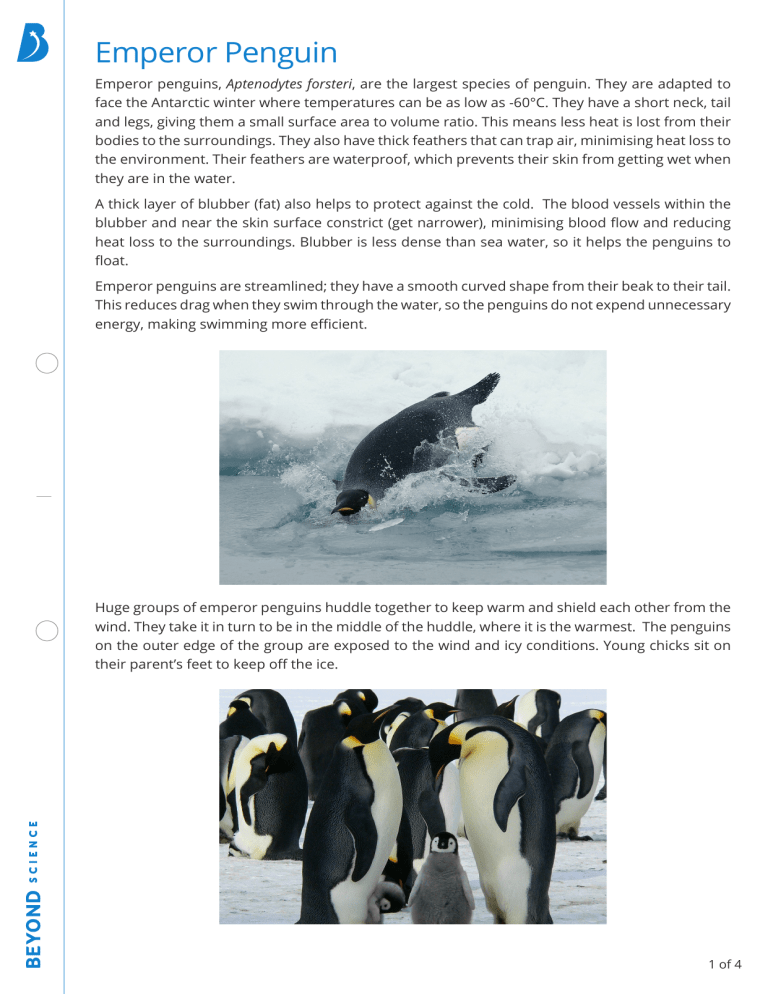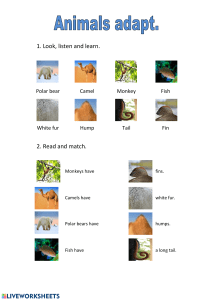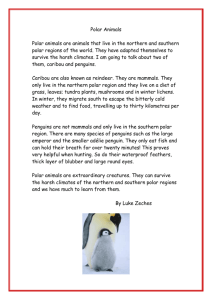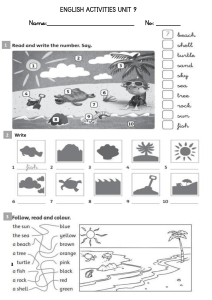
Emperor Penguin Emperor penguins, Aptenodytes forsteri, are the largest species of penguin. They are adapted to face the Antarctic winter where temperatures can be as low as -60°C. They have a short neck, tail and legs, giving them a small surface area to volume ratio. This means less heat is lost from their bodies to the surroundings. They also have thick feathers that can trap air, minimising heat loss to the environment. Their feathers are waterproof, which prevents their skin from getting wet when they are in the water. A thick layer of blubber (fat) also helps to protect against the cold. The blood vessels within the blubber and near the skin surface constrict (get narrower), minimising blood flow and reducing heat loss to the surroundings. Blubber is less dense than sea water, so it helps the penguins to float. Emperor penguins are streamlined; they have a smooth curved shape from their beak to their tail. This reduces drag when they swim through the water, so the penguins do not expend unnecessary energy, making swimming more efficient. Huge groups of emperor penguins huddle together to keep warm and shield each other from the wind. They take it in turn to be in the middle of the huddle, where it is the warmest. The penguins on the outer edge of the group are exposed to the wind and icy conditions. Young chicks sit on their parent’s feet to keep off the ice. 1 of 4 Polar Bear Polar bears, Ursus maritimus, are the world’s largest land-based carnivores and are found in Alaska, across the Arctic Ocean, Greenland, Norway and Russia. They mainly eat seals but can also hunt small whales. Polar bears are opportunist carnivores which means they will eat roots, seaweed or other vegetation if there is no other food available. However, polar bears cannot survive off this diet for very long as they rely on having lots of fat in their diet, the majority of which comes from seal blubber. As well as requiring fat to provide energy, polar bears also use this to build up a thick layer of insulation (blubber) around their bodies, which can be up to 10cm thick. The thick layer of blubber can also act as an energy reserve when there is little prey available. Polar bears have large, strong claws that enable them to grasp onto and hold their prey. Their claws are also useful for gripping ice and snow. They have fur in between the pads on the paws, which helps to increase friction and therefore prevent slipping. This enables polar bears to run at high speeds for short distances and to walk for long distances on ice, allowing them to hunt over a wider area. Their paws also have a large surface area, which reduces the pressure exerted on the snow and ice, preventing the polar bears from sinking. Polar bears are strong swimmers. Despite their large size, they are streamlined, which reduces drag whilst they are in the water. Polar bears have short legs, a short tail and small round ears, giving them a small surface area to volume ratio. This minimises heat loss to the surroundings. Their skin beneath their fur is black, meaning it is a good absorber of heat, which keeps the polar bear warm. The fur is made from hollow, transparent fibres that reflect visible light, making the fur look white. This provides camouflage against the ice and snow so they can sneak up on prey. The thick fur also acts as a layer of insulation. 2 of 4 Leopard Seal Leopard seals, Hydrurga leptonyx, are the second largest species of seal in the Antarctic. They are one of Antarctica’s top predators, second only to the orca (killer whale). They have strong jaws that open wide, enabling them to bite and seriously injure large prey such as penguins. Leopard seals also have strong, sharp teeth to grip into and tear the fur and skin of prey such as fur seals. Their whiskers make them excellent hunters. The whiskers are sensitive sensory organs that allow the seals to feel for fish in dark waters. Leopard seals also have gaps in their back teeth which act as sieves; they can filter krill from the water as they swim. When leopard seals dive, their nostrils can close to prevent water from entering their respiratory systems. This stops the seals from drowning. A high blood oxygen carrying capacity means leopard seals can survive up to 30 minutes in between breaths. This is useful for hunting and finding food as they can hide under the surface of the water waiting for seabirds to land, then strike and catch their prey off guard. Leopard seals have a streamlined body shape which helps to minimise drag when they are in the water. The streamlined shape is, in part, due to the thick layer of blubber beneath their skin. The blubber also minimises heat loss which means they can survive in sea temperatures as low as -5°C. Blubber also helps the leopard seal to float as blubber has a lower density than sea water. Leopard seals have large front flippers that act like paddles, allowing them to displace large volumes of water at once increasing their swim speed and efficiency. 3 of 4 Reindeer Reindeer, Rangifer tarandus, also known as caribou, are a species of deer that live in Alaska, Northern Asia, Canada, Greenland and Siberia. They eat a variety of shrubs, fern, moss, grass and even lichen and fungi. They use their large paddle like hooves to clear away snow and scrape off fungi, moss and lichen from tree bark, branches and rocks. Reindeer migrate long distances in search of food. Reindeer have ultraviolet vision, which helps them see against the snow. The fur and urine of potential predators absorb ultraviolet light, making them appear black to the reindeer and therefore easily detected. Lichen also absorbs ultraviolet light, so large patches of lichen appear black and are easily seen. Reindeer usually live in large numbers called herds. Living in large herds reduces an individual’s chance of being caught and killed by a predator. The tendons in the feet make a clicking sound when they walk. Reindeers use this sound to locate each other when they are travelling in herds and cannot see each other in harsh conditions such as snowstorms or at night. Their large hooves provide a large surface area preventing the reindeer from sinking into the snow. The hooves consist of two toes and two large claws which are extremely useful for digging, as well as for gripping onto ice and rock. Fur between the toes provides insulation and increases friction between the hooves and the ice, preventing the reindeer from slipping. Both male and female reindeer grow antlers. Their antlers are used to clear snow in search of food and for defence against predators. They can also be used against each other during breeding season; males fight for mates and females defend food, territory and their young. Reindeer have a thick fur coat which provides insulation and protects them from harsh weather conditions. When they breathe in, the air enters a chamber in the nostril and is warmed before it enters the body. Reindeer have a compact body and short tail, giving them a small surface area to volume ratio and therefore reducing heat loss. 4 of 4




